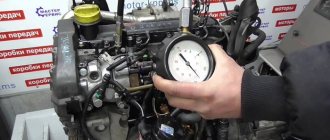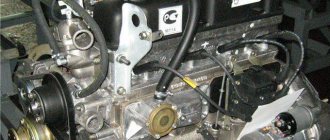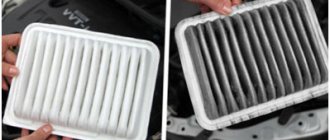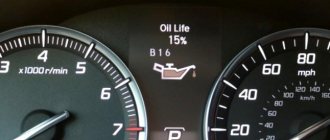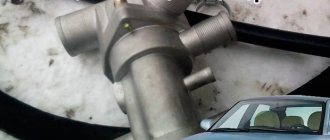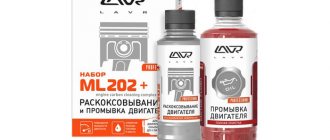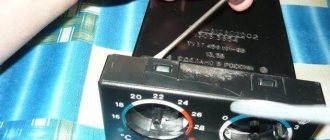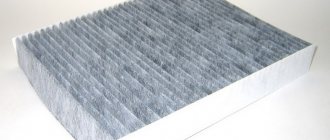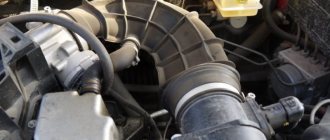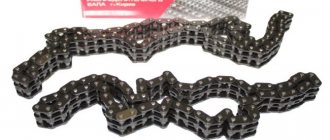VAZ 2111
| Name | Index |
| Volume | 1.5 liter (1499 cm3) |
| Number of cylinders | 4 |
| Number of valves | 8 |
| Fuel | Petrol |
| Injection system | Injector |
| Power | 77 hp |
| Fuel consumption | 8.2 l/100 km |
| Cylinder diameter | 82 mm |
VAZ 21114
| Name | Index |
| Volume | 1.6 liter (1596 cc) |
| Number of cylinders | 4 |
| Number of valves | 8 |
| Fuel | Petrol |
| Injection system | Injector |
| Power | 81.6 hp |
| Fuel consumption | 7.6 l/100 km |
| Cylinder diameter | 82 mm |
| Name | Index |
| Volume | 1.5 liter (1499 cm3) |
| Number of cylinders | 4 |
| Number of valves | 16 |
| Fuel | Petrol |
| Injection system | Injector |
| Power | 93 hp |
| Fuel consumption | 7.0 l/100 km |
| Cylinder diameter | 82 mm |
Engine VAZ 2110 1.5 l. 16-valve injector
- Working volume – 1499 cm3
- Number of cylinders – 4
- Number of valves – 16
- Cylinder diameter – 82 mm
- Piston stroke – 71 mm
- Power – 93 hp (68 kW) at 5600 rpm
- Torque – 128 Nm at 3800 rpm
- Compression ratio – 10.5
- Power system - distributed injection
- Acceleration to 100 km/h – 12.5 seconds
- Maximum speed – 180 kilometers per hour
- Average fuel consumption – 7.2 liters
The most successful in design were the VAZ-2110 engines with a displacement of 1.6 liters. Today, their modifications are installed on almost all Lada models that are currently sold. These are the 8-valve VAZ-21114 and the 16-valve VAZ-21124 . Actually, the same 1.5 liter engines became the basis for these units. The creation recipe turned out to be quite simple: increasing the height of the cylinder block by only 2.3 mm and increasing the piston stroke from 71 mm to 75.6 mm. At the same time, the diameter of the cylinder, and therefore the pistons, turned out to be the same 82 mm.
But to avoid valve damage, special recesses have now been made in the 1.6-liter pistons. Therefore, if the timing belt breaks, the valves of 1.6-liter engines do not bend . Some competent car owners, when overhauling a 1.5 liter engine, install new pistons with recesses from a 1.6 liter engine. The piston is the same size. This solves the problem of bent valves, but the compression is slightly reduced due to the different shape of the piston crown. Photos of the piston with recesses for the valves of the VAZ-2110 engine are attached.
VAZ 21124
| Name | Index |
| Volume | 1.6 liter (1599 cc) |
| Number of cylinders | 4 |
| Number of valves | 16 |
| Fuel | Petrol |
| Injection system | Injector |
| Power | 89.1 hp |
| Fuel consumption | 7.0 l/100 km |
| Cylinder diameter | 82 mm |
Dynamics of a VAZ 2110 with a 16-valve engine
In addition, the ten with a 1.6-liter engine and 8 valves was more dynamic at the bottom. The 16-valve engine boasted high speeds and torque of 131 Nm, but at 3800 rpm. The car simply wouldn't go any lower. The 8-valve engine coped well with city traffic and was easier to operate and maintain. And the reason for this is a completely different design of the cylinder head.
Adjusting the valves on a 10 with a 16-valve engine turned out to be a long process, and repairs to a huge aluminum twin-shaft head could drag on for weeks. Bad components, incorrect settings, any little thing could lead to a drop in the already not herculean power, high consumption of 95 gasoline.
VAZ engine 16 valves or 8, what are the differences?
What's the difference between 8 and 16 valve engines? When there are 4 valves per cylinder instead of 2, then it is possible to more effectively use a larger area of the combustion chamber for gas exchange and make the 2112 engine “breathe” more intensely - especially at high speeds, when very little time is allocated for the processes of admitting a charge of fresh mixture and cleaning the cylinders from exhaust gases .
As a result, the 16-valve engine has become more powerful and makes the 10 a faster car. But the torque of the 2112 16-valve engine at low speeds will be acceptable only for calm drivers who prefer economical, leisurely movement without intense acceleration.
Tuning
And in conclusion, I would like to say about tuning the VAZ 2110 engine.
In the VAZ 2110, engine tuning is very easy to do. To do this, you only need a tool and a room. This process can be done not only in a specialized workshop, but also in your garage.
Tuning a VAZ 2110 engine requires only a set of tools and patience:
- The first step is to simply replace the camshaft with a better one. Due to this, power will increase and engine performance will improve.
- You can also install a new crankshaft to increase the volume of the unit. If this is not done, then further tuning of the VAZ 2110 engine will be in vain.
- The installation of a compressor is quite simple. This unit allows you to increase power and get good torque.
- It is worth noting that tuning the VAZ 2110 engine can be done by anyone. This does not require special experience or skills. It is enough to know the structure of the car and have locksmith skills. Experts recommend installing a high-quality stock piston so that it can withstand about 0.5 bar.
Question answer
How much does a VAZ 2110 car weigh?
weight from 1010 to 1360 kg.
In what year did they start producing the VAZ 2110?
The start of production of the well-known VAZ 2110, which we see on the roads of the country, was in 1991.
Which VAZ 2110 engine is better?
On 1.5 16v, when the timing belt breaks, the valve bends and this factor is very annoying, but regarding the 1.5 8v, it seems to me that it is rather weak, but if you don’t drive fast, it will do. 16 valves are more dynamic, but more expensive to repair.
What kind of oil should I use?
- Motul 8100 X-clean 5W40 4 l. Guarantees complete cleanliness of the motor, as well as its individual elements. It hardens at a temperature not lower than -40 degrees Celsius.
- Liqui Moly Molygen New Generation 5W-40 4 l. An interesting advantage of this material: the possibility of saving fuel up to 4%. Suitable for year-round use. At the same time, it extends the service life of the vehicle by effectively combating deposits. Ensures smooth and precise operation of the motor. The only negative is the price, it is quite high.
- Castrol Edge 5W-40 4 l. This lubricant uses titanium compounds, which have a more than high level of resistance.
- Oil change every 10,000 km. During the running-in period 5,000 km.
Normal compression on a VAZ-2110
Typically, compression is checked using a special device. It is recommended to do this regularly.
This helps determine the degree of wear of the motor and rings, as well as the piston itself. Normal cylinder pressure on a VAZ-2110 with 8 valves should be from 10 to 12 atmospheres .
Normal compression in the cylinder.
It is also worth noting that sometimes the pressure in different cylinders may differ . If it is 0.5-0.7 atmospheres , then this phenomenon is normal and should not cause concern.
Abnormal compression
This happens when there are more or less atmospheres in the cylinder than in others.
Such an engine will not be able to operate normally. He absolutely needs to carry out repairs.
Causes
Burnout of the gasket between the block and the head is a fairly common defect.
There can be many reasons why there may be a difference in compression. Experts highlight the main ones. This:
- The head and block gaskets are burnt out. It just needs to be changed.
- The head is not tightened. The gasket may burn out here.
- The rings don't hold. The reason here is the wear of the rings or their breakage. If the pressure drops in one cylinder, this often indicates a broken ring. This will require piston repair.
- Coked rings. They will need to be cleaned.
- Block wear. Happens rarely.
- Motor overheating.
- The piston is broken or burnt out. There is no compression at all.
- Valves not adjusted.
Characteristics of VAZ 2110
| Engine | 1.6 l, 8kl (Euro-2) | 1.6 l, 16cl (Euro-2) | 1.6 l, 16cl (Euro-3) |
| Length, mm | 4265 | 4265 | 4265 |
| Width, mm | 1680 | 1680 | 1680 |
| Height, mm | 1420 | 1420 | 1420 |
| Base, mm | 2492 | 2492 | 2492 |
| Front wheel track, mm | 1410 | 1410 | 1410 |
| Rear wheel track | 1380 | 1380 | 1380 |
| Load capacity, kg | 475 | 475 | 475 |
| Luggage compartment volume, dm 3 | 450 | 450 | 450 |
| Permissible total weight of a towed trailer with brakes, kg | 1000 | 1000 | 1000 |
| Permissible total weight of a towed trailer without brakes, kg | 500 | 500 | 500 |
| Wheel formula / drive wheels | 4x2 / front | ||
| Car layout diagram | Front-wheel drive, front engine, transverse | ||
| Body type / number of doors | Sedan/4 | ||
| engine's type | injection gasoline, four-stroke | ||
| Engine displacement, cm 3 | 1596 | 1596 | 1596 |
| Supply system | distributed injection with electronic control | ||
| Number and arrangement of cylinders | 4, in-line | ||
| Maximum power, kW (hp) / rev. min. | 59 (80) / 5200 | 65,5 (89) / 5000 | 65,5 (89) / 5000 |
| Maximum torque, Nm at rpm | 120 / 2700 | 131 / 3700 | 131 / 3700 |
| Maximum speed, km/h | 170 | 180 | 180 |
| Fuel consumption by driving cycle, l/100 km | 7,2 | 7,2 | 7,2 |
| Fuel | AI-92 (min) | AI-92 (min) | AI-92 (min) |
| Transmission | mechanical | ||
| Number of gears | 5 forward, 1 reverse | ||
| Main gear ratio | 3,7 | 3,7 | 3,7 |
| Acceleration to 100 km/h, s | 13,5 | 12 | 12 |
| Steering | with hydraulic booster, rack and pinion steering mechanism | ||
| Tires | 175/65 R13 | 175/65 R13 | 175/65 R14 185/60 R14 |
| Fuel tank capacity, l | 43 | 43 | 43 |
VAZ 2110, greetings from the 80s
The VAZ 2110 began mass production only in 1996, and in parallel with those cars that it was supposed to replace. But there was demand, so both eights and nines were produced for a long time. 2110 was a kind of flagship model of the Volga Automobile Plant.
Despite the fact that, from the first years of production to the last copies, the car was structurally identical to the VAZ 21099, from time to time minor improvements appeared, which the plant was in a hurry to present almost as new models.
Brief overview of the car
The VAZ 2110 (or Lada 110) is a four-door sedan with front-wheel drive and an original design. Serial production of the five-seater Lada 110 began in 1996 and continues to this day (the car is currently assembled under the Bogdan 2110 brand at the LuAZ plant in Ukraine).
Since 1996, the production of several modifications of the VAZ 2110 has been launched, among which you can find models with both an engine (on later versions). Such technical characteristics of the VAZ 2110, such as the type and displacement of the engine (four-cylinder petrol with a volume of up to 1596 cc), as well as the maximum speed of the Lada VAZ 2110 (170 km/h for the engine and more than 180 km/h for the engine) make this front-wheel drive The sedan is ideal for use in urban environments to this day.
Among the distinctive features of the VAZ 2110, which is classified in the upper price segment of LADA cars, one can also note the presence of an immobilizer, a gasoline vapor recovery system and a special on-board control system (diagnostic unit). There was the possibility of installing electric lifts (in fact, they were installed), as well as power steering.
The VAZ 2110 was produced by AvtoVAZ with various power plant options, including a limited version, which is now extremely difficult to find.
All engines have a certain number of valves, power, volume, design. That is, there are differences, so in our material we will consider each of the possible engines in more detail.
Briefly about the design of the Lada 2110 8 valve engine
This unit is an adaptation of the VAZ 21083 internal combustion engine for cars of the tenth family. The engineers of the AvtoVAZ concern were faced only with the task of rearranging additional equipment for the new model. The main innovation is that the tanks are finally secured and do not dangle.
In all other respects, this is a typical carburetor 8-valve power unit with an overhead camshaft and a timing belt drive. There are no hydraulic compensators and the valve clearances have to be adjusted manually.
Nail Poroshin spoke about a typical problem with the GDS of the 2110 carburetor.
Similar engines from other manufacturers:
